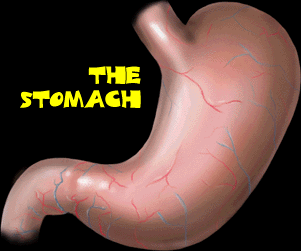The digestive system

Food gives us energy. The dinner we ate last night will let us run, walk, think, and write today. If we stopped eating we would run out of energy and die.
Here is some interesting information about the digestive system:
How food can go from a sandwich and salad and be turned into the energy needed to hit a home run is amazing. The food will pass through more than 22 feet of tubing, be mixed with chemicals from four different glands, be separated between useful and not useful elements and the whole process could take more than 14 hours! Digestion really has two missions:
- Break down the food we eat into parts so tiny, that the useful elements of food can actually be absorbed into our bloodstream and sent throughout our body.
- Get rid of any leftover parts of the food that our body can’t use.
Our digestive system goes through 9 basic steps:
Teeth- Digestion starts here. The job of the teeth is to start tearing and crushing the food down into small enough pieces so that it can fit down our throats.
Saliva- The salivary gland in located underneath the back of our tongue. It creates our saliva or spit. This helps soften the food in the mouth so that it is easier to swallow. Saliva is also the first of several chemicals that start to break down foods into simpler forms.
Tongue- The tongue is a muscle that works with the food and saliva to form a “ball” that can be swallowed. Of course, the tongue also contains taste buds that helps us tell the difference between salty, sour, sweet, and bitter foods.
Esophagus- The esophagus is simply a transportation tube from the mouth to the stomach. When we swallow, what we are really doing is closing a trap door in our throat called the epiglottis. This sends food down the esophagus and prevents food from going down the trachea (or windpipe) and into our lungs. Food moves down the esophagus using muscles not gravity.
Stomach- The first stop after the esophagus is the stomach. Once the food gets to the stomach the stomach uses chemicals to try to make the food tinier. These chemicals are called gastric juices and the include hydrochloric acid and enzymes (chemicals that break down food). The food is moved around in the stomach and mixed with the chemicals for about 3 or 4 hours. When it is done in the stomach, the food is now a cream-like liquid call chyme. The food is still not small enough the get into our blood stream and it has not provided the body with anything useful yet. Now a valve at the end of the stomach opens sending the food past the liver.
Liver/Gall Bladder- At this point, our food is hit with more chemicals. The liver makes a chemical called bile but bile is not stored in the liver. Instead it is stored in the gall bladder. When the gall bladder mixes bile with our food, it does an important job: breaking down the fat (from milk, butter, cheeses) into tiny droplets. This fat will supply us with much energy later.
Pancreas- The pancreas also adds a digestive chemical as the food leaves the stomach. This digestive juice works on breaking down the carbohydrates (from breads, potatoes, etc.) and the proteins (from meats, cereals, peanut butter).
Small Intestine- The small intestine is the real hero of the digestive system. The small intestine is a tube that is about 22 feet long! This is where the real digestion takes place. As the food passes through, it is mixed with the new chemicals and soon our “food” is now digested small enough to be put to use by the body. Along the walls of the intestine are thousands of tiny fingers called villi. Blood vessels (capillaries) in the villi can absorb the tiny food molecules and send them off to the rest of our body through the blood.
Large Intestine- Whatever the body cannot put to use is sent to the large intestine. Many plants, for example, contain cellulose which cannot be digested. The big job of the large intestine is to remove water. Water has been necessary up until now but it is no longer needed and in the large intestine water is sent into the blood stream . Food spends about 12 hours in the large intestine where it become feces and later leaves the body through the anal opening when we go to the bathroom.